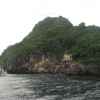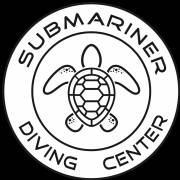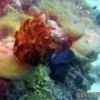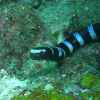Dive in Philippines
-
Cesar's Reef Dakak Island, Philippines
Tiny reef area with bounded coral covers. Rich with large fish such as napoleon wrasses (Chiefly tropical marine fishes with fleshy lips and powerful teeth; usually brightly colored), tuna and parrot fish. View schools of surgeon fish, barracuda (Any voracious marine fish of the genus Sphyraena… -
The Wreck Dakak Island, Philippines
Seven year old sunken passenger liner with bottom depth of 180 feet, and 130 feet at its highest point. Big schools of fish from deck such as black and white snappers, red snapper, jacks, and groupers. Great visibility. For adventurous, experienced divers. -
Octopus Wall Dakak Island, Philippines
Small wall with pretty growth, octopuses, scorpion fish, sponges, tubastrea, continuous into a slope to the north with some strange crinoids covered formations provide a very scenic view of rudderfish, groupers, etc. -
Buchok's Reef Dakak Island, Philippines
A series of large coral mounds with nice selection of marine life: giant reef rays, small white tip sharks, unicorn surgeons, snappers and sweetlips. For experienced divers only. -
Challenger Reef Dakak Island, Philippines
The reef area is almost half the size of Aligua, its top is about 125 feet deep, with soft coral growth. The northern part of the island has short walls and a long narrow opening and a few juvenile fish. -
Romy's Reef Dakak Island, Philippines
Plenty of coral mounds, with enormous basket sponges, a fine and nice selection of reef fish and invertebrates. Sightings have been reported of blue spotted rays and a few turtles. Some coral damage and unfruitful areas though; eastern area though has massive coral thickets and extends through to… -
Eskuelahan Dakak Island, Philippines
Named for the numerous schools of fish (snappers, jacks, rainbow runners, surgeons, etc) and occasional tuna found in the area. It is a center of activity with fish of all sizes feeding. Giant frog fish have been also sighted. Currents may be a problem for novice divers. -
Dimakya West Dimakya, Philippines
On the west side of the island, right in front of the lounge is a reef with a beautiful coral garden. The reef features soft and hard corals in an explosion of colors, amazingly tamed reef fish, and untold surprises. On the steep slope, which runs down to 17 meters (about 55 feet), there are alot of… -
The Classroom Dimakya, Philippines
On the west side of the island, right in the middle of this confusion of corals and color is a clearing with white sand at 3 meters (10 feet) of water. This is the site called the classroom, indeed a very ideal place to teach scuba. -
Dimakya North Dimakya, Philippines
On the north side of the island is a gently sloping reef. The corals are not as colorful as in the classroom but the chances of seeing mantas, eagle rays, and marine turtles are greater in this area, as well as lobsters and a great assortment of reef fish call this home. -
Dimakya North-East Dimakya, Philippines
The northeast end of the island features a small place that has quite a number of Porites (hump corals), some of them as big as a small one bedroom house. The place is a good spot for macrophotography: nudibranchs, crinoids, slugs, and other various invertebrates proliferate in this reef.) -
Crossing Dimakya, Philippines
This reef is a natural submerged bridge between Dimakya Island and Islang Walang Langaw.The reef is about 2 to 3 kilometers long(about a mile). This reef can account for three to four dive spots and each spot can be a different experience for the diver. The main distinguishing characteristic of this… -
Island Walang Langaw Dimakya, Philippines
South: The name, literally translated into English means ISLAND WITH NO TREES, is located on the east side of Club Paradise, just ten minutes away by boat. The reef consists of extensive hump coral formations on a shallow, gently sloping terrain.The reef starts at 3 meters(10 feet) and ends at… -
Island Walang Tao Dimakya, Philippines
North: This short but beautiful reef can be reached by a 15 minute boat ride from the resort. This island's name in English is THE ISLAND WITHOUT PEOPLE. The reef gently slopes down to 18 meters (60 feet), is home to one long black tip shark and on occasions, 2 meter (7 foot) nurse sharks patrolling… -
Barry's Reef Dimakya, Philippines
This elongated submerged reef is located in a large cove that is about 20 minutes away from the Club. The top of the reef is at 3 to 4 meters ( 12 feet) and the slope sharply drops to 27 meters (90 feet).There are plenty of macro subjects on this reef. Spanish dancers, juvenile spotted sweetlips,… -
Gato Island Malapascua, Philippines
Gato Island is one of our most famous dive sites. TSD's famous saying is that "You come to Malapascua to see the thresher sharks, but you leave remembering Gato". Gato is a marine reserve and sea snake sanctuary. It has at least five dive sites with a huge diversity of marine life. We are constantly… -
Gato Island: White Tip Alley Malapascua, Philippines
You are 95% guaranteed to find whitetip sharks sleeping under rocks, and if you are lucky you will see them circling. They grown to huge sizes - sometimes over 2 meters. Other life here includes banded boxer shrimp, nudis, seahorses and scorpion fish, spider crabs, frogfish, lionfish and whip coral… -
Gato Island: Nudibranch City Malapascua, Philippines
As the name implies, we find nudibranchs galore at this site. Also around are lots of hermit crabs and scorpion fish. -
Gato Island: Cathedral Malapascua, Philippines
Explore some of the more amazing rock formations around Gato, including the stunning Cathedral rock. This is a great place to see sharks - we have seen as many as 15 whitetips circling. It is also possible to see blue-spotted rays. -
North Point Malapascua, Philippines
Beautiful soft coral and varied marine life including frogfish of different colors, fire urchin hikers specially zebra crabs, candy crabs, and nudibranchs. Great macro. An amazing hangover (see left) could easily keep you busy for the whole dive. -
North Wall Malapascua, Philippines
This is a short wall at 24m, about 10m long by 6m high. Its nooks and crannies hide a wide variety of life including giant frogfish and nudibranchs. After investigating the wall, swim out from the wall into a sandy area which is home to a field of sea pens and many other critters, then let yourself… -
Bugtong Bato Malapascua, Philippines
Bugtong Bato is an underwater pinnacle, very near Malapascua. There is a large school of batfish is residence as well as squid, mackerel, nudis, scorpionfish, lionfish, zebra crabs and whip coral shrimp. -
Quiliano Malapascua, Philippines
A beautiful site with better than average visibility and fish life, soft corals, spearing mantis shrimp, pygmy sea horses and a lot of macro. -
Deep Rock Malapascua, Philippines
Deep rock is 5 minutes from Malapascua. It starts at 5 meters and slopes down to 22m. It has frogfish, nudis, pygmy seahorse, robust ghost pipefish, juvenile batfish, harlequin sweetlips, spotted leather coral cowries and and bigger black cowries. -
Bantigi Malapascua, Philippines
This is a great muck dive - some divers have told us that Bantigi is even better than Lembeh!. It starts as a shallow reef that turns into a sandy bottom at around 12m where you can find all kinds of unusual creatures. There are goby and shrimp living together in holes everywhere and the tiny rocks… -
Kimud Shoal Malapascua, Philippines
Kimud Shoal is a sunken island. The top of the island lies at 12-16m, and the steep sides drop off to 200m+. Its main attraction is the school of up to 200 hammerheads, which can usually be seen regularly between December and May, and occasionally through the rest of the year.Hammerheads are more… -
Shore Diving Malapascua, Philippines
-
Evolution's House Reef Malapascua, Philippines
Our very own house reef is one of the best muck dives in the country. Just 3 minutes from our beach front is an incredible array of macro delights. Here we repeatedly see pairs of Crinoid Squat Lobsters and Imperial Shrimps. At dusk dozens of Bobtail Squid appear. Coconut Vein Octopi are regulars… -
Lighthouse Wreck Malapascua, Philippines
The wreck at Lighthouse was a Japanese World War II landing craft. It was bombed just before landing with a large shipment of cement destined for a gun emplacement. The wreck is in very shallow water - 3m average - and is broken up with the hull in two pieces. The rocks that you will see are… -
Snake Island Pamilacan, Philippines
This is a sunken plateau about 18m deep, lying in the south of Pamilacan, covered with corals. This dive site lies in the middle of the ocean and usually there is a very strong current. Plan your dive, jump in on the side the current comes from and then sweep over the plateau with it. We saw 8… -
House Reef Pandan Island, Philippines
Depths between 2 - 20m. Ideal for beginners or a warm-up dive. A wide variety of coral fish such as parrot fish, butterfly fish, trigger fish and sergeant major can be seen. Nearby 'lion fish den' consists of a couple of rocks overgrown with soft and hard corals and teeming with lion fish. -
Coral Garden East and West Pandan Island, Philippines
Another easy but beautiful dive. In a lively garden of hard and soft corals all kinds of marine life can be observed such as surgeon fish, trigger fish, coral trouts, stingrays, moray eels, sand eels, cuttle fish and an occasional turtle. In the deeper parts of the dive, large gorgonians and Neptune… -
Napoleon Wall Pandan Island, Philippines
On the edge of the wall at 30 m big schools of snappers and mackerels can be watched, although the big attraction of this dive site are the big napoleon wrasses reaching up to 1,5 m in length, which often come for a visit. Tunas and trevallys are common visitors to this reef that is overgrown with… -
Neptune's Land Pandan Island, Philippines
This dive is a flat plateau connecting Napoleon Wall and the Coral Garden east. As the name indicates Neptune cups to a considerable size can be found. Also turtles seem to favor this place. -
Anchor & Christmas Tree Pandan Island, Philippines
On a underwater hill at a depth of 32 m, completely overgrown by corals, a huge anchor has come to rest at least 50 years ago. Snappers, barracudas and pelagic fish can be seen. At the bottom of the hill is a tree-like sea nettle, all white. -
North Wall Pandan Island, Philippines
A sheer drop from about 7- 35 m makes that place an interesting dive site. Although not as many fish as in other parts of the island can be seen, the overhanging corals create a very special atmosphere. Pelagic fish such as tuna and mackerel are frequent. -
Barracuda Deep Pandan Island, Philippines
Probably the most advanced dive around the island. A wall at 30 m depth facing the South China Sea is the place to see big schools of trevallys, fusiliers, surgeon fish, spanish mackerels and unicorn fish. Eagle rays and napoleons are often seen as well as barracudas up to a size of 1,5 m. The whole… -
AN LST Subic Bay, Philippines
This vessel is situated between Grande Island and the southern tip of the runway, this landing craft lies in 32 meters, sitting upright with its door open. The average dive is 28-35 meters, and the visibility is normally 15-30 meters, slightly deeper than other wrecks and often with slight current,… -
El Capitan Subic Bay, Philippines
The wreck is situated near the inner channel marker of Ilanin Bay. A small freighter, the El Capitan lies on its port side with its stern in 5 meters while its bow rests in 20 meters. Starting the dive from 18 meters there's a nice swim through the accommodation area and one can expect to encounter… -
Patrol Boat Subic Bay, Philippines
This vessel is situated in Triboa Bay at a depth of 20 - 25 meters (60-75 feet). Sitting upright the wreck is a great dive with visibility from 7-13 meters (20-40 feet)and plenty of marine life. We have placed a cable from the bow of the ship across to the coral reef where the divers can finish…









